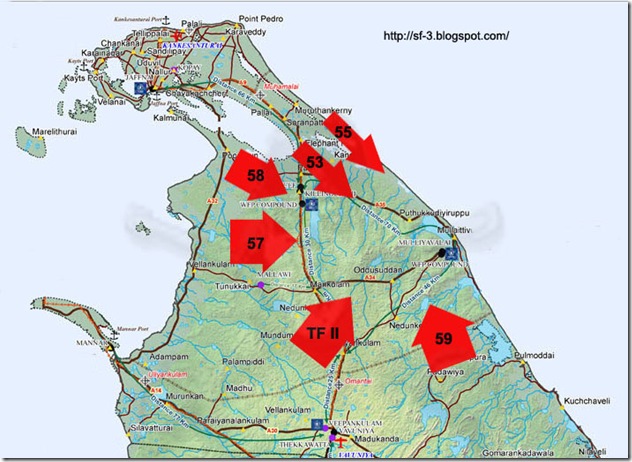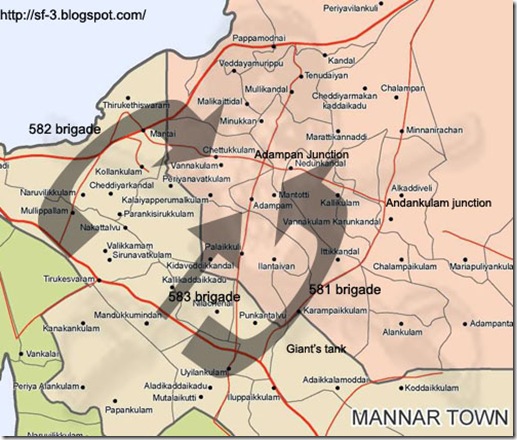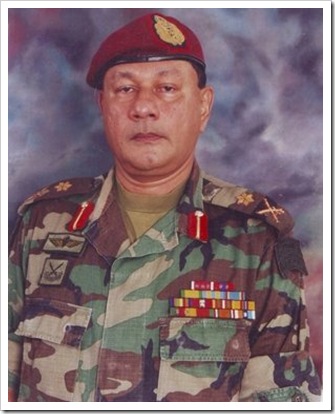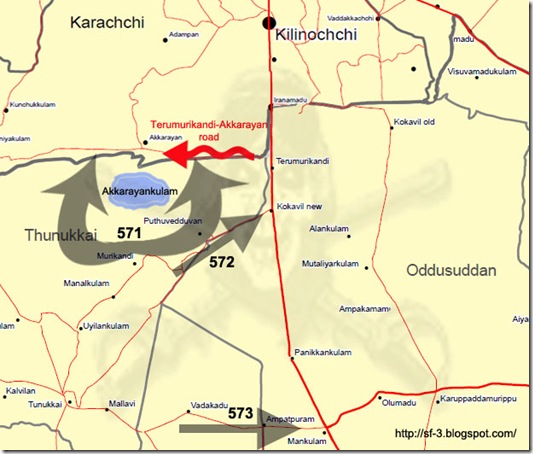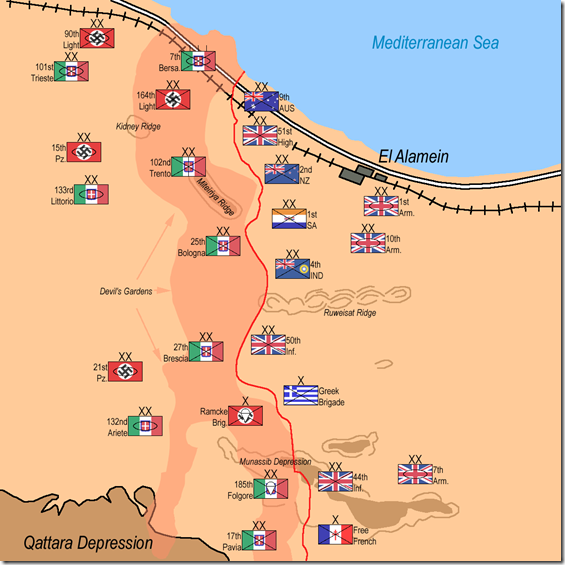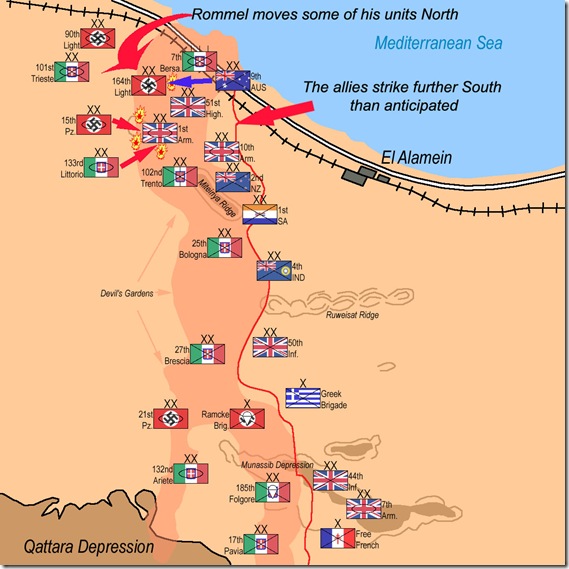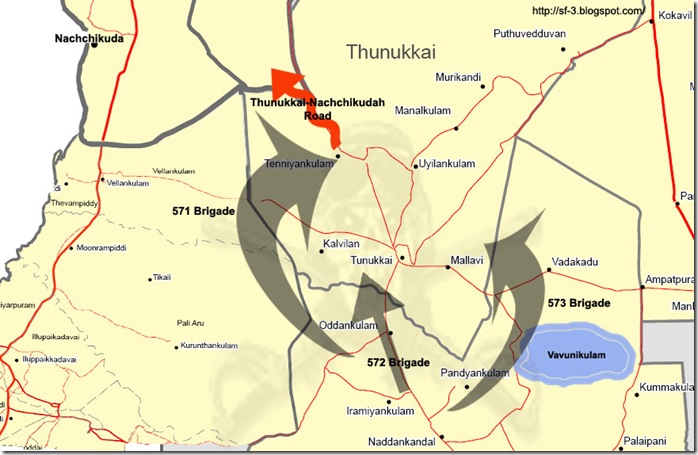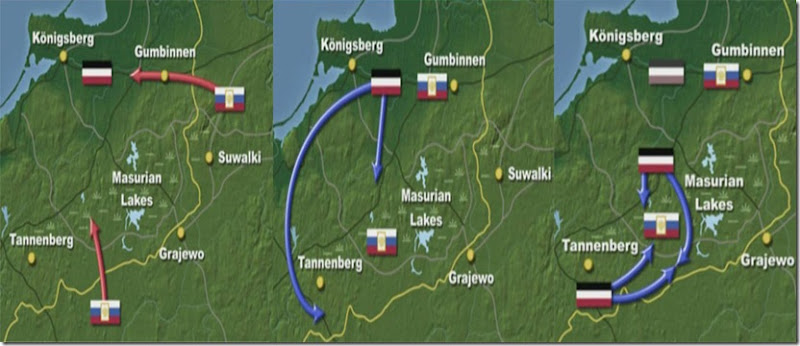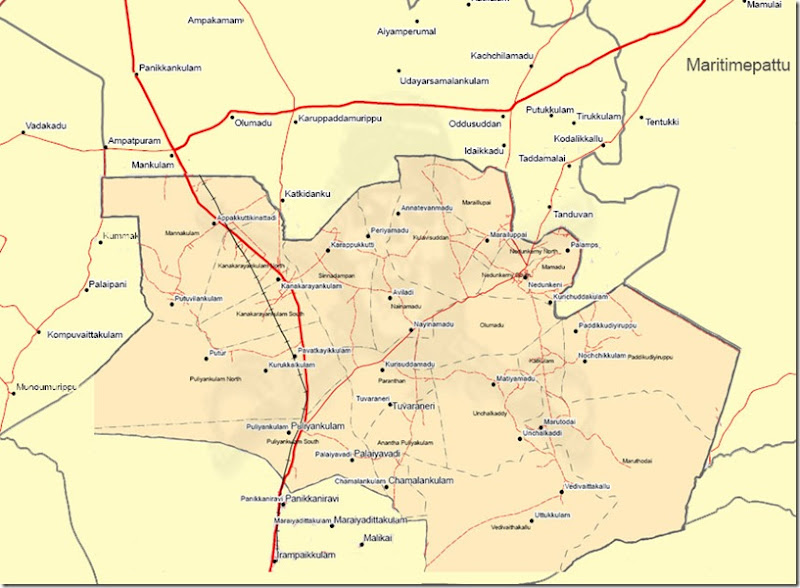
On the aftermath of the capture of the entire JAFFNA peninsula in 1995 the battleplanners had drawn the blueprints to continue the series of operations into mainland Wanni with the main aim of extending the EPS defences up to KILINOCHCHI. With the intention of stalling these preparations the Tamil Tigers set about to dismantle the isolated MULLATIVU base on the 18th of July 1996 with Ceaseless Waves I.
Since the fall of the base the Tamil Tigers have been in control of the coastal littorals spanning from KOKKUTHUDUVAI to EPS. This coastal stretch for decades have been quite significant to the Tamil Tiger military machine especially to its sea wing. Millions of dollars worth of cargo have been unloaded along this coastal stretch and hundreds of Sea Tiger missions have been conducted along this belt against both the SLA and SLN. The lack of land routes through the dense WELIOYA jungles also meant that the sea route was the most viable and quickest to reach areas South of MULLATIVU. Furthermore MULLATIVU being strategically positioned midway along the East coast made it ideal to intercept the sea bridge connecting the Jaffna peninsula to TRINCOMALEE. The observation posts at SAMPUR/SUDAIKUDA used to relay vital intelligence of naval movements to the sea tiger bases littered around these coasts.
This heightened activity of the sea tigers along this stretch was the primary reason for the SLN to establish its doctrine of making a rendezvous point for the FAC escorts of COMNORTH and COMEAST just off the MULLATIVU coast and to conduct the now defunct Operation Waruna Kirana as a deterrent against weapons smuggling along the same waters.
With the establishment of the current politico-military machine in 2005, one of the main objectives highlighted in the first Security Council Meeting was to clip the abilities of the Sea Tigers and thereby starve the Tamil Tigers of its much needed logistics. Carrying on the tradition of securing the coastal belt before jutting inland which successfully secured the Eastern province, the battleplanners set about to implement a similar doctrine towards Wanni. While securing the Western belt fell on the THOPPIGALA heroes of TF1, the responsibility of the Eastern belt fell on the newly formed 59 Division.
Since the birth of 59 HQ on the 13th of December 2007 it has made serious inroads to the Tamil Tiger heartland maintaining roughly a 16Km front along the Eastern coast.
At the moment 591 Brigade who laid siege on ALAMPIL are moving along the coastline and are operating South of TANNIYUTTU/CHILAWATTAI areas. Knowing very well the 59 troops were converging on MULLATIVU the Tamil Tigers set about creating an extension to the L bund all the way from the IRANAMADU tank connecting KALMADU, VISUVAMADU, MULLIYAWALI and CHILAWATTAI. However due to forward operating elements of 591 the Tamil Tigers have failed to extend the bund up to the coast at CHILAWATTAI. Such forward operating exploitation forces are known to operate around areas hugging the lagoon and the Vattapalai amman kovil. Some recon teams have also managed to conduct Forward Observation (FO) of the MULLIYAWALI airstrip facility. Once 591 intercepts the A34 it would severe MULLIYAWALI from MULLATIVU and the coast.

Image of MULLIYAWALI airstrip. Note the paved North Eastern section and the unpaved but hardened South Western extension. Source- Jane's
593 Brigade meanwhile are heading towards the all important MULLIYAWALI area which holds important Government institutions such as the hospital and Vidyananda college. North of this buildup area holds the Tamil Tigers' latest air strip which has been undergoing a 1000m extension towards the South West. As highlighted earlier such a lengthy runway is not meant for the Tamil Tigers' Zlin/PC7 fleet but larger aircraft. Given its meager resources it is unlikely the Tamil Tigers would have invested so much time and effort on a white elephant. A similar guerilla organisation the FARC have had successful airdrops over Southern Colombia where aircrafts have flown over the Canary islands and Guyana dropping its cargo and flying through to IQUITOS in Peru's side of the Amazon river. Similar drops were to be made from KIGALI in Rwanda to the Alpha one base of UNITA rebels in Angola. The mercenary pilot who was recruited for the mission Brian 'Sport' Martin recalls him landing a Boeing 707 on a 'very narrow' 1800 yard runway with a landing weight of over 12 tonnes during a mission to Congo. In his interview he has said "Whatever else one may think of them, the crews involved in this clandestine world are consummate aviators who are able to fly in conditions beyond normal limits". It is indeed beyond normal limits to attempt a landing on a 1000m airstrip. Perhaps this explains why the Tamil Tigers are pursuing to extend the MULLIYAWALI runway up to 2000m. The 1000m extension may also serve any logistics aircraft with sufficient over-run area if it attempts a landing during the rough monsoons which will help the Tamil Tigers to exploit the instrumental limitations of the SLAF. And hence they will be in a better position to entice any interested mercenary aviator to take up the mission of illegally navigating to the Wanni. This also brings to light one hidden advantage the Zlin 'airstrikes' pose. Any takeoff of the Zlin aircraft and its return back to Wanni unscathed no matter how inaccurate the bombing run is; can still be used to display the infancy of the Sri Lankan air defence/interceptor capability to any interested mercenaries and support any recruitment of such mercenary pilots easily to the organisation. If the possibility of a successful interception was high with a high risk landing on a short runway with a heavy landing weight, the Tamil Tigers may find it hard to recruit any potential mercenary pilots who are skilled enough for the job. If that is the case the plausible option would be to air drop the cargo without making a landing.
Meanwhile 592 Brigade have made strides to prepare the ground for a possible link up of the 59 Division with two other Divisions, namely TFIII and TFIV. 592 augmented the efforts of the newly established TFIV by cutting off the MULLATIVU-NEDUNKERNI road from KODDALIKKALLU and are expected to intercept the ODDUSUDAN-MULLATIVU A34 road. This would render the Tamil Tiger resistance towards TFIII incapable of operating at full efficiency. The rapid movements of the daring commanders of this Division has made the Tamil Tigers to reposition the planned earth bund. According to captured/surrendered cadres the initial plan had been to position the bund defending the all important A34 which provides the Tamil Tigers a vital road link cutting through the dense jungles. However this was not to be.
With the possible fall of both MULLIYAWALI and TANNIYUTTU the guerilla stronghold PUTHUKKUDIYIRUPPU comes under immense threat since the road from TANNIYUTTU junction runs straight to PUTHUKKUDIYIRUPPU via VATTAPPALAI amman kovil and KEPPAPULAVU. However this road runs through an urban area. Given the fact that the modern SLA doctrine of exploiting as much as cover and concealment via circuitous routes, it can be expected for the SLA to employ concealed, dispersed, small unit independent manoeuvre techniques. This terrain offers plenty of cover but the useable dead ground is often irregularly shaped and irregularly distributed. Hence to make most of it careful scouting, mapping of minefields, MG posts, sites of fighting positions to fit the peculiarities of each unit's immediate surroundings is required. Long gone are the text book formations that marched towards the objective along open roads and then held onto the objective with formulaic defensive formations.
If the 57/58 Divisions are attempting to force the door on the Tamil Tiger heartland by assaulting KILINOCHCHI/PARANTHAN, then for those two divisions the areas surrounding MULLATIVU turns out to be the deep battle space where the Tamil Tigers are known to house its commanders/ammo dumps/supply routes/hospitals treating injured cadre and training bases for new recruits. Any strikes towards the rear reduces the command efficiency of the enemy, forces the enemy to restrict its movements and dents its aura of invincibility. Such strikes substantially increases the time the guerillas require to counter concentrate, move supplies or replacements of a sufficient force to the forward lines. This can also compel the enemy to disperse its stocks/fuel hence further slowing resupply and can seriously depress the enemy's operating tempos. Without a stable rear the guerillas can still continue to fight and offer resistance, however the performance will fall dramatically when they are denied the essential support and coordination that separates a military from an armed mob.
With 59 Division inching towards the Tamil Tiger rear the Sri Lankan forces have easy access to this all important deep battle sphere. With the NAYARU lagoon and ALAMPIL coming under Government's writ, the 59 commanders have been busy establishing additional fire support bases surrounding this area making Tamil Tiger strongholds that are known to hold many vital guerilla installations within range of the T59 130mm howitzers. Such a development is a serious concern to the Tamil Tigers since it allows the field commanders a real time strike capability. However the saving grace for the Tamil Tigers has been the high concentration of civilian population held up in this area which pose as a deterrent. Since the SLA have no precision guided artillery shells such as the XM982 Excalibur 155mm projectile, artillery fire have been directed towards targets that are assessed to pose less collateral damage. SLAF's arsenal of precision guided munitions (PGMs) will still continue to see action till concentration of the civilian population are thought to be reduced to 'safer' levels.
Furthermore is the fact that with every inch 59 forges ahead, is an inch the Tamil Tigers lose of their one and only coastal belt. Due to the rough seas that persisted during the last two months and SLN's instrumental limitations in such rough seas the Tamil Tigers had managed to unload significant amounts of supplies along the MULLATIVU coast. This was verified by civilians who managed to cross over into GOSL territory and surrendered cadres. Unfortunately this was also verified by the very high volume of indirect fire which some field commanders explained as the 'mortar monsoon'.
The fierce defensive battle the Tamil Tigers are conducting along the PARANTHAN/KILINOCHCHI/IRANAMADU axis according to the pro-tamiltiger pundits is a war winning battle plan. However the ground situation does not reflect this at all. As mentioned previously in the doctrine of a defensive battle plan, its main objective is to invite the enemy to attack, deter the enemy long enough and grind them till the defending commanders decide an opportune moment to launch their counterattack to completely reverse the present status quo. Such a counterstrike at any stage remains the crucial factor in the defensive battle, battleplan. It is almost always the last act. However, the great danger of this battleplan is that the defender may not really know the enemy's full real intentions. It very well might be the enemy who actually has the initiative intending to pin the bulk of defensive forces down and outflank them from elsewhere.
With so many avenues of approach, divisions and units available for the Sri Lankan battle planners to outfox the Tamil Tigers unlike in any other previous Eelam wars, they; and they only hold all the cards of surprise and dynamism to take any of the available avenues that may not be eagerly apparent to the enemy. As indicated by the last poll conducted in my portal, not even the diligent followers of the Sri Lankan war were able to predict what SLA's next objective was after POONERYN. As always only time told...






